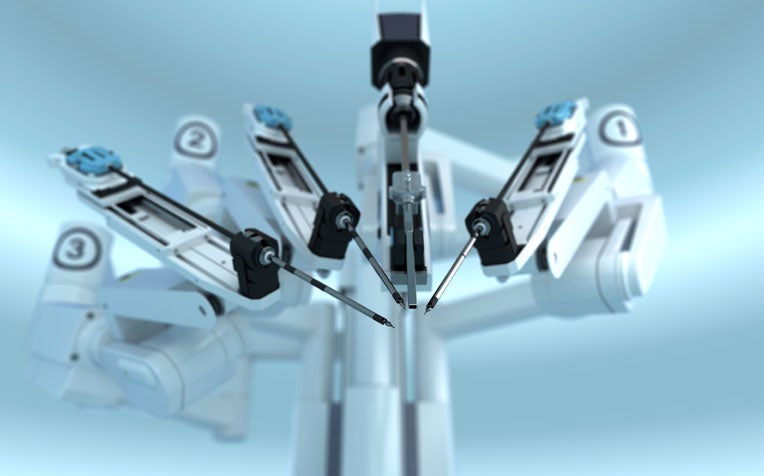
Keyhole surgery is not usually an option when a uterine fibroid is very large, but robotics can help surgeons perform the procedure safely.
Ms Ng's fibroids weighed nearly half a kilogram when they were removed via surgery in May 2013. The largest of the four benign growths removed from her abdomen measured 14.5cm in length. But except for an expanding waistline, Ms Ng had few other symptoms. “I just thought I was putting on weight,” she said.
What are uterine fibroids?
Uterine fibroids are a common condition among women of child-bearing age. These usually harmless smooth tumours, that grow in the muscle layer of the womb, often develop when women are in their 30s or 40s. When the fibroids grow too large, however, they can cause heavy periods, abdominal discomfort, back pain, frequent urination, and fertility problems.
Ms Ng, a mother of two, found out she had fibroids during a regular gynaecological examination earlier this year. The relatively large size of Ms Ng’s fibroids would normally limit her surgical choices to an open procedure – the conventional method where a large incision is made for the surgeon to perform surgery through. But the main fibroid, which was a pedunculated fibroid, was “on a stalk, so we were able to perform keyhole robotic-assisted surgery,” said Dr Peter Barton-Smith, Senior Consultant at the Department of Obstetrics and Gynaecology, Singapore General Hospital (SGH), a member of the SingHealth group.
Usually, surgeons will not use minimally invasive or keyhole laparoscopic surgery if the patient has too many fibroids or if the growths are too large. In such cases, open surgery is typically the only surgical option. Conventional laparoscopic surgery generally limits cases to patients who have about three to five fibroids, each less than 5-6cm long, said Dr Barton-Smith.
Another way for surgeons to decide on the type of procedure to perform is the size of the uterus. When the fibroids have caused the womb to enlarge to the equivalent size of a 16-week pregnancy, that is usually around the limit for conventional keyhole surgery, said Dr Barton-Smith. “With robotics, we can push that limit to a 20-week pregnancy, but after that, usually open surgery is the only option,” he said.
“This limit can be pushed because the computer-enhanced technology allows the surgeon a greater range of movement to deal with larger masses, that are very difficult to achieve with conventional straight laparoscopic instruments,” he added.
Flexible robotic arms allow for highly precise surgery
During surgery, Dr Barton-Smith made five tiny incisions in Ms Ng’s abdomen to allow for the insertion of a high-definition 3D camera, and tiny but highly precise and flexible surgical instruments. Sitting at a console a distance away, he was able to look inside her abdomen and perform surgery.
“It’s like being inside the patient,” he said of the camera’s ability. The highly flexible joints of the robot’s surgical arms, meanwhile, translated his hand movements into small, precise movements inside the body to cut the surface of the uterus and then to “shell the fibroids out, much like shelling peas,” he said.
The incision in the uterus was then stitched closed. Using a device known as a morcellator, a hollow tube with a circular blade at one end, he finally pulled the fibroids out of Ms Ng’s abdomen. The morcellator was used to cut the fibroid into long strips, allowing the otherwise huge mass of tissue to be removed through the small incisions.
With robotic-assisted surgery, said Dr Barton-Smith, “patients experience less pain, less blood loss, a shorter hospital stay, and a quicker return to normal activity – in two to three weeks after surgery, compared with the usual six weeks for people who undergo open surgery.”
Ms Ng’s surgery took about three-and-a-half hours. After two days in hospital, she was discharged. Patients who undergo open surgery for the procedure normally go home after three to five days.
Fibroids: Common but mostly harmless
Fibroids are common and can grow to very large sizes. But they are rarely cancerous.
About one in five women will develop fibroids, usually in her 30s or 40s. “But less than one in 1,000 patients will have a form of cancer inside the fibroids,” said Dr Barton-Smith.
Fibroids do not cause trouble for most women because they stay relatively small. But some of these benign tumours can grow very large. “The largest I’ve ever removed weighed 9kg,” said Dr Barton-Smith.
When the fibroids grow very large, they may start pressing on the other organs, such as the kidneys. In such situations, the woman might start experiencing heavy bleeding during menstruation, discomfort in the abdomen, pain in the lower back, and frequent urination. Some women can also end up having problems conceiving.
In Singapore, Dr Barton-Smith said, “the added problem is that women appear to not only have fibroids but also endometriosis (a condition in which womb lining grows outside the uterus) at the same time, which makes it more complicated. A lot of Asian women have both problems at the same time, which is new to me.”

In addition to the very large pedunculated fibroid, Ms Linda Ng had three other smaller fibroids, known as submucosal and intracavitary fibroids. According to Dr Barton-Smith, these types of fibroids can be removed by surgery through the cervix if they are small enough. Larger ones, and the other types of fibroids, often have to be removed by surgery through the abdomen.
Ref: S13
Contributed by















 Get it on Google Play
Get it on Google Play